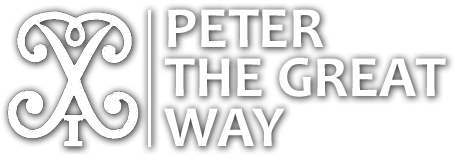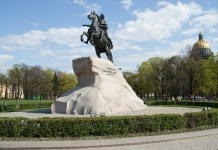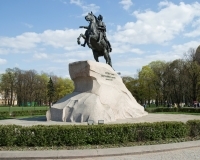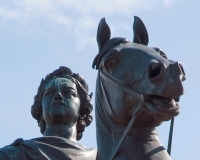Monument to Peter I on Senate Square in St. Petersburg
Immediately after Catherine II had ascended the throne on July 17, 1762, the Senate decreed to install a monument to the Empress. However, she declined this honor, pointing out that a monument to Peter I had to be created in the first place. The Empress did not like the bronze sculpture that Bartolomeo Rastrelli began to work on while Peter was alive and that was substantially completed by 1744. Upon the recommendation of French philosopher and writer Denis Diderot, Catherine II invited French sculptor Etienne Maurice Falconet to work on a monument, and so he came to St. Petersburg in 1766.
Falconet was familiar with Voltaire’s The History of the Russian Empire under Peter the Great first published in 1763 and other writings about Russia. In his talks with Diderot, he reflected on the artistic interpretation of the image of Peter as follows: “I have to show him to mankind <…> as the creator, the legislator and the benefactor of his country <…>. My Tsar has no rod in his hand. He extends his beneficent hand over the country he travelled across. He rises at the top of the rock that is his pedestal. This is an emblem of the difficulties he conquered.”
The image of a horseman spurring his horse above a cliff is Falconet’s brilliant find which has no equals in the world. At the same time, the work was based on the old European tradition of equestrian statues, some of the remarkable examples of which include works by sculptors of the Italian Renaissance Andrea del Verrocchio and Donatello. A rider on a reared horse appeared in European sculpture later. One of the first representations was the statue of Spanish King Philip IV in Madrid. It was made by Florentine sculptor Pietro Tacca to a drawing by Diego Velasquez in 1640.
In the first half of 1767, Falconet created a small model of the sculpture and it was approved by the crowned customer. In the early 1768, he began to make a larger model, which was completed in the summer of 1769. According to Falconet, he could not manage to make Peter’s head, so it was eventually made by his student, 20-year-old Marie Collot. In less than three years, Falconet’s concept took shape in a plaster model which was to be cast in bronze.
As the sculptor worked, a search for a site to install the monument was underway. In 1768, Catherine II ordered to install the monument in the square between the Neva River, the Admiralty and the Senate building. With the Neva River, on whose banks Peter founded a new city, the Admiralty as a symbol of the Russian Fleet created by Peter, and the Senate as an embodiment of lawmaking in the Petrine era, the site perfectly matched Falconet’s idea. Symbolically, during the times of Peter I, the site was occupied by the first wooden church of St. Isaac which was consecrated in the name of the heavenly protector of the Tsar, as Peter was born on May 30 which is the feast day of Saint Isaac of Dalmatia.
Originally, it was planned to build the monument’s pedestal of several granite stones. The search for stones began in the outskirts of St. Petersburg in the summer of 1767. More than 140 cubic fathoms of stones had to be extracted not only for the pedestal, but also for the foundation and the embankment. A stone of suitable size was found 12 versts (about 8 miles) away from the capital, near Konnaya Lakhta. The “Thunder Stone” was 27 feet high, 44 feet long and 22 feet wide (approximately 8 x 13 x 7 m). The processing of the stone began as it was transported. The dimensions and configuration of the granite block needed to be changed according to the sculptor’s conception. It took more than one year to bring the stone to the shore of the gulf. The transportation of the stone from Lakhta along the Gulf of Finland and further along the Malaya Neva and the Bolshaya Neva rivers continued from August 28 to September 26, 1770.
The preparations for casting in bronze began in 1769. After a long search for a caster, Falconet began to work himself engaging Emelyan Khailov as his assistant. The casting began on August 7, 1775; however, the mold was broken by molten metal. Thanks to Khailov’s prompt action, it was possible to continue the casting. The lower part of the sculpture was completed, but its upper part needed to be recast which was done in July 1777.
Falconet continued to chisel the bronze statue until he left Russia on September 1, 1778. From 1780 onward, the work to finalize and install the monument was directed by architect Yuri Felten. The inscription with bronze display letters in the Russian and Latin languages was made according to the text edited by the Empress herself. It reads as follows: “PETRO primo CATHARINA secunda MDCCLXXXII” on the right side and “TO PETER the First EKATERINA the Second, the Year 1782” on the left side.
The inauguration took place in the presence of the Empress on August 7, 1782. By that time, Falconet had already left Russia and he was sent a golden medal and a silver medal minted in honor of the ceremony.
The monument’s further fate is inseparably linked to the history of St. Petersburg. The celebration ceremonies associated with the anniversaries of the city in 1803, 1903 and 2003 took place in the area next to it. During the heroic defense of Leningrad, the monument was carefully hidden. Major restoration work on the unique sculpture was carried out in 1909 and 1976.
The monument on Senate Square is the first sculptural monument in Russia. A brilliant work of plastic art, with its perfect composition, symbolism of the location, and dramatic history of creation, it has been inspiring artists and poets for new creations for more than two centuries. The first place among them belongs to Alexander Pushkin’s A St. Petersburg Story, after which we refer to the monument as the “Bronze Horseman”. Literary works devoted to the monument were written by Fyodor Dostoevsky, Alexander Blok, Andrei Bely, Anna Akhmatova, and Vladimir Mayakovsky. Paintings and drawings featuring the monument were made by Vasily Surikov and Alexander Benoit.
The Bronze Horseman is an official symbol of St. Petersburg.




